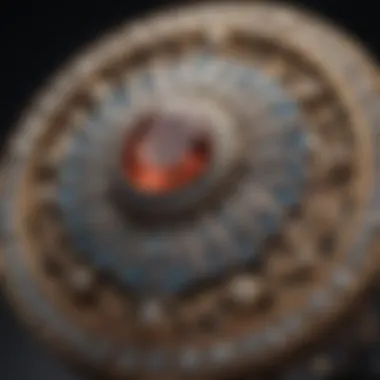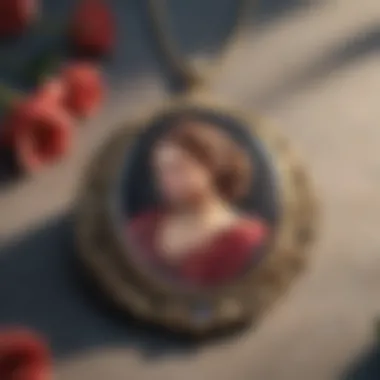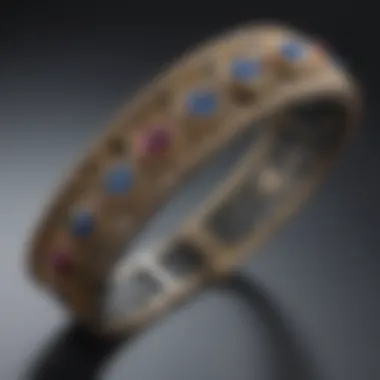The Significance of Mother's Day Jewelry: A Comprehensive Guide


Intro
Mother's Day provides a unique opportunity to express gratitude and love towards mothers. This occasion holds profound emotional weight, prompting individuals to seek gifts that resonate with personal connections. Among various offerings, jewelry stands out as a timeless choice. It is not just an ornament but a powerful symbol of affection and appreciation.
Jewelry has the potential to convey deep meaning. Whether it's a necklace, bracelet, or pair of earrings, each piece can encapsulate memories and emotions. Understanding the significance of Mother's Day jewelry helps in selecting meaningful gifts. A comprehensive look at gemstones, their historical background, and cultural insights can significantly enhance the decision-making process for choosing the right piece.
While exploring the beauty of jewelry, it is essential to recognize its invaluable role in representing relationships. The following sections delve into the finer details of gemstones, their classifications, and the historical significance they carry. This guide will illuminate how these factors intertwine with the celebration of Mother's Day, enriching the gifting experience.
Prelude to Mother's Day Jewelry
The significance of jewelry in celebrating Mother's Day extends beyond mere aesthetics; it encompasses emotional ties, cultural interpretation, and personal expression. Gifts like necklaces, bracelets, or rings are not simply ornamental. They serve as tokens of appreciation, showcasing a deep respect and love for mothers.
In this article, we will explore how jewelry has become a central element of Mother's Day celebrations. By understanding its role, readers can appreciate why choosing the right piece is essential. Jewelry can embody shared memories and signify enduring bonds.
When selecting jewelry, it is vital to consider personal style. Each piece can narrate a story unique to the recipient, making the gift more meaningful. Understanding the nuances of choices and how to tailor them can amplify one's expression of gratitude.
An exploration of the different types of jewelry, including necklaces, bracelets, and rings, will illustrate their individual appeal. Each selection conveys a different sentiment, resonating differently with various personal experiences and relationships.
Additionally, this guide will delve into the cultural significance of jewelry. Around the globe, the interpretation and tradition surrounding Mother's Day gifts vary. Exploring these facets will offer insight into how jewelry can reflect broader cultural values.
Finally, practical advice on selecting the ideal piece will be provided. From material choices to customization options, these insights will equip the reader with the necessary tools for making informed decisions.
"Jewelry is not just an accessory; it's a reflection of our identity and our relationships."
In summary, the importance of Mother's Day jewelry lies in its ability to express emotions and solidify familial bonds. This article aims to offer comprehensive knowledge for those looking to enhance their Mother's Day celebrations through thoughtful and significant gifts.
Historical Context of Mother's Day
Understanding the historical context of Mother's Day is crucial in appreciating the significance of jewelry as a gift for this occasion. The celebration has evolved considerably over time, reflecting cultural values and social norms. Examining its roots provides insight into how gifts, particularly jewelry, became an essential part of this holiday.
Origins of Mother's Day Celebrations
Mother's Day, as we recognize it today, is rooted in various ancient traditions. The earliest celebrations can be traced back to the ancient Greeks and Romans, who held festivals honoring mother goddesses. For instance, the Greeks celebrated Rhea, while the Romans honored Cybele. These early customs formed a basis for more contemporary festivities.
In the United States, Mother's Day gained prominence in the early 20th century. Anna Jarvis is often credited with its establishment as a national holiday. In 1908, she organized a memorial for her mother, which sparked a movement for a dedicated day to recognize mothers. In 1914, President Woodrow Wilson proclaimed it a national holiday. This transformation from a simple celebration to a national holiday highlights the increasing importance placed on the maternal figure in society.
Today, Mother's Day continues to hold a sentimental value, with many countries adopting their own versions and dates of celebration. Understanding these origins helps underscore the meaning behind gifting jewelry, reflecting not just affection, but the historical acknowledgment of motherhood itself.
Evolution of Gift-Giving Traditions
Gift-giving on Mother's Day has diversified over the years. Initially, flowers and handwritten notes were the most common gifts. As the custom evolved, the significance of jewelry became prominent. Jewelry symbolizes lasting affection and commitment, offering a tangible expression of feelings.
- Sentimental Gifts: Jewelry pieces like lockets and bracelets became popular because they can be personalized. Initials, birthstones, and engraved messages add a unique touch, enhancing the emotional value.
- Cultural Influences: Different regions have adapted their gift-giving traditions based on local customs. In the UK, for instance, the practice of giving gifts has varied in significance from one community to another, reflecting broader socio-economic conditions.
As the meaning of Mother's Day has expanded, so too has the array of gifts. The intersection of personal style and cultural values now plays a significant role in selecting jewelry for this holiday. Jewelry pieces have come to serve not only as gifts but as lasting reminders of the bond between a mother and her child, reinforcing the enduring impact of this special day.
Types of Jewelry for Mother's Day
Jewelry holds a place of importance when it comes to Mother's Day gifting. This chapter focuses on several common types of jewelry that resonate with sentiments associated with motherhood. Each piece carries its meaning and value, making it crucial for the giver to choose wisely. The thoughtful selection of jewelry not only reflects personal taste but can also symbolize deep affection.
Necklaces: A Timeless Choice


Necklaces are perhaps one of the most enduring symbols of love and connection. When choosing a necklace for Mother's Day, one must consider the styles that align with the recipient’s personality. A simple pendant can convey elegance, while a multi-layered design might express a more vibrant nature.
The choice of material also plays a significant role. Sterling silver remains a popular choice due to its affordability and classic appeal. Alternatively, gold necklaces, whether yellow or white, often carry a sense of luxury and permanence.
Additionally, personal touches such as engraved initials or meaningful dates can elevate the gift. This makes the necklace not just an accessory but a cherished keepsake.
Bracelets: Personal Touch
Bracelets are unique in their versatility and intimacy. They can be worn every day, serving as a constant reminder of the bond shared with the wearer. Options range from delicate chains to bolder statement pieces.
A charm bracelet, for instance, allows customization. Each charm can signify a memory or an important moment, making it exceptionally personal. There is a sense of storytelling imbued in the charms.
When selecting a bracelet, the style should fit the mother’s lifestyle. A mother who enjoys active life may prefer a simpler design that combines comfort and durability.
Rings: Symbolism and Sentiment
Rings often symbolize deep connections, making them a profound gift choice. They can represent commitment and love, beyond mere adornment. Birthstone rings are particularly meaningful for mothers as they can incorporate the stones of her children. This creates a unique and personal piece that adds sentimental value.
The material choice also matters greatly. Platinum rings tend to signify durability and strength, attributes associated with motherhood.
Consideration also extends to the ring's design — classic styles often prevail, but modern and unique designs can also make a strong statement. The significance behind the choice of ring could resonate well with a mother who appreciates both aesthetics and meaning.
Earrings: Subtle Elegance
Earrings offer a subtler form of expression. Their elegance can complete an outfit while also providing appreciation for the mother's style. Studs or hoops can be versatile and easy to wear for daily activities.
Choosing earrings may focus on the stone type. Pearls carry classic elegance, while colorful gemstone earrings can add playful flair.
Like other forms of jewelry, personalization can enhance the gift’s meaning. Initialed or birthstone earrings offer both beauty and a touch of individualized charm.
"Jewelry is a very personal gift. It has to reflect the personality of the recipient."
Cultural Significance of Jewelry as Gifts
Jewelry has always held a unique position in human culture. It transcends mere ornamentation, representing emotions, values, and deep connections. Within the context of Mother's Day, gifting jewelry carries profound significance. These gifts serve as tokens of love and appreciation, embodying feelings that are often difficult to articulate.
Jewelry plays a special role in familial relationships, particularly between mothers and their children. As a gift, it conveys a message of respect and admiration. Traditionally, jewelry has not just been about aesthetic appeal; it also acts as a medium for expressing lasting sentiments. The selection of a specific piece is, therefore, a reflection of the giver's thoughtfulness and understanding of the recipient.
Jewelry as Symbols of Affection
When gifting jewelry on Mother's Day, the chosen piece often stands as a symbol of affection. It is not uncommon for certain kinds of jewelry to become heirlooms, passed down from generation to generation. The significance of such pieces enhances over time, as they carry stories and memories attached to them. For example, a simple gold necklace may remind a mother of her child’s first school event, enriching the emotional value attached to it.
The materials used in jewelry also contribute to its significance. Precious metals such as gold and silver are appreciated not only for their beauty but also for their durability. Gemstones, with their unique meanings, add another layer of sentiment. A sapphire may symbolize wisdom, while a pearl often embodies purity. Such associations further deepen the emotional impact of the gift.
"Jewelry has a language of its own, speaking on behalf of emotions that words often cannot convey."
Global Perspectives on Mother's Day Gifts
The traditions surrounding Mother's Day vary widely across cultures, yet jewelry consistently appears as a favored gift choice. In the United States, the day's emphasis is often on personal and thoughtful gifts. In many Asian cultures, gifting gold jewelry holds significant weight, as it is viewed as an investment and a show of respect. Similarly, in Middle Eastern cultures, jewelry may bear cultural symbols that enhance its significance during celebrations like Mother's Day.
Each culture assigns different meanings to the same pieces of jewelry. In certain South American countries, colorful, handcrafted jewelry may be favored as a way to celebrate uniqueness and personal style. Conversely, in some European traditions, simplicity and elegance rule, with a focus on classic designs that withstand the passage of time.
Key Takeaways


- Jewelry represents deep connections and emotions.
- It often serves as a lasting symbol between mothers and their children.
- Material and cultural significance amplify its value as a gift.
By understanding the cultural importance of jewelry, one can better appreciate the sentiments behind gifting these items on Mother's Day. It's not simply about adornment; it's about honoring the bond that exists, making this tradition a beautiful act of love.
Material Considerations for Mother's Day Jewelry
When it comes to selecting Mother's Day jewelry, one crucial factor to consider is the materials used. The choice of material affects not only the aesthetic value but also the durability, symbolism, and overall significance of the gift. Understanding these materials can lead to more informed purchasing decisions that reflect both appreciation and thoughtfulness.
Precious Metals: Gold, Silver, and Platinum
Precious metals play a significant role in jewelry design. Gold, silver, and platinum are often preferred due to their beauty and intrinsic value. Each metal brings its unique character and appeal, making it essential to understand their differences.
- Gold: Traditionally seen as a symbol of wealth and prestige, gold is favored for its warm tones and luster. It comes in various karats, with 18k and 14k being popular choices for jewelry. Gold is relatively malleable, which makes it suitable for intricate designs.
- Silver: Sterling silver is widely used in jewelry due to its affordability and versatility. Its cooler tone complements many gemstones, offering a contemporary look. However, silver requires more maintenance to prevent tarnishing compared to gold and platinum.
- Platinum: Known for its rarity and durability, platinum is the most resilient of the three. Its heavy weight and hypoallergenic properties make it ideal for those with sensitive skin. Platinum's natural white sheen enhances the brilliance of accompanying gemstones, making it a preferred choice for high-end pieces.
Selecting the right metal is about aligning it with the preferences and style of the mother receiving the gift. A thoughtful choice in metal can make the jewelry piece more meaningful.
Gemstones: Meaning and Selection
Gemstones add depth and personalization to Mother's Day jewelry. Each gemstone carries its own meaning, making them significant additions to any piece. Understanding the qualities of various gemstones helps in selecting what’s most appropriate.
- Diamonds: Often associated with purity and strength, diamonds symbolize everlasting love. They are timeless and can elevate any design, making them a popular choice for special occasions.
- Sapphires: Known for their deep blue hue, sapphires signify wisdom and nobility. They are durable gemstones suitable for everyday wear, adding a touch of elegance to any piece without compromising durability.
- Emeralds: With their lush green color, emeralds represent rebirth and love. They can be seen as a representation of growth and new beginnings, ideal for a mother celebrating new stages in life.
- Birthstones: Incorporating a mother's birthstone or her children's birthstones offers a personal touch. This connection strengthens the emotional impact of the gift, creating a sentimental value that transcends mere aesthetics.
Selecting a gemstone involves considering both its visual appeal and the meanings that resonate with the recipient's experiences and sentiments. It is this careful selection, paired with the right material, that ultimately creates a piece of jewelry carrying profound significance.
Trends in Mother's Day Jewelry
As Mother's Day approaches, many people often find themselves exploring the trends that shape the jewelry gifting landscape. Understanding these trends can significantly enhance the experience, ensuring that the chosen piece resonates with the recipient. The significance of this topic lies in its ability to guide gift-givers toward selections that are not only beautiful but also meaningful and contemporary.
Trends reflect the evolving tastes and values expressed in jewelry design. They allow individuals to connect with the preferences of mothers today. Focusing on recent trends can lead to a more personal and memorable gifting experience.
Personalized Jewelry: Customization Options
Personalized jewelry has surged in popularity in recent years. Gifting a piece that reflects personal significance can deepen the emotional connection. Options for personalization range from initials and names to birthstones and engraved messages. Each customized piece transforms into a unique testament of affection.
Some popular forms of personalized jewelry for Mother's Day include:
- Initial Necklaces: Simple yet elegant, these necklaces allow mothers to wear the initials of their children close to their heart.
- Birthstone Rings: These rings can be customized to include the birthstones of each child, making it a colorful representation of family life.
- Engraved Bracelets: A message or a date engraved on a bracelet can serve as a great reminder of a special moment, infusing sentimentality into the gift.
The ability to tailor a piece specifically for her makes personalized jewelry a top choice for Mother's Day.
Sustainable and Ethical Choices
Sustainability is an increasing concern in the jewelry industry. More consumers are prioritizing the environmental and ethical implications of their purchases. This has led to a rise in sustainably sourced materials, with jewelers focusing on conflict-free diamonds and recycled metals. Choosing sustainable and ethical options not only honors the recipient but also supports broader environmental and social causes.
When considering sustainable Mother's Day jewelry, look for:
- Recycled Metals: Jewelry made from recycled gold or silver reduces the environmental impact associated with mining.
- Lab-Created Gemstones: These stones possess the same physical and chemical properties as natural gems but are produced in a controlled environment, often with fewer ethical concerns.
- Fair Trade Practices: Purchasing pieces from brands that ensure fair labor practices can enhance the gift’s sentiment, aligning personal values with gifting choices.
Embracing sustainable practices in jewelry buying can reflect a commitment not only to the loved one being celebrated but also to the planet.
Recognizing these trends allows the giver to be thoughtful and informed, further enriching the experience of selecting jewelry for Mother's Day.


Practical Advice for Selecting Mother's Day Jewelry
Selecting the right piece of jewelry for Mother's Day can be both a challenging and rewarding process. Jewelry often holds significant sentimental value, which means choosing the appropriate item requires thoughtful consideration. It is essential to marry personal tastes with the emotional significance behind the gift. This section will cover several critical aspects to keep in mind when selecting Mother's Day jewelry, ensuring that your choice reflects both the recipient's style and your heartfelt intentions.
Understanding Personal Styles and Preferences
Every individual has their own unique tastes in jewelry. Understanding these preferences is vital. For instance, some mothers may prefer simple and understated designs, while others might be drawn to bold and intricate pieces. To discern personal styles, consider the following:
- Observe Previous Choices: Look at what jewelry the mother figure typically wears. Is it gold or silver? Does she favor contemporary designs or vintage styles?
- Lifestyle Considerations: Take into account her daily routine. If she leads an active life, opt for durable pieces that can withstand daily wear.
- Occasions for Wear: Consider whether the jewelry will be worn daily or for special occasions. This can help narrow down suitable options.
Setting a Budget: Value vs. Sentiment
Budgeting is an integral part of selecting jewelry. While some might think expensive pieces hold more value, sentimentality can greatly outweigh monetary cost. Here are some points to help balance value and sentiment:
- Determine Your Price Range: Decide what you can reasonably spend without straining your finances. A clear budget can guide your choices.
- Value of Sentimental Jewelry: Sometimes, less expensive items that hold significant memories can be more valuable than higher-priced gifts. Consider custom or handmade options that reflect a personal connection.
- Quality over Quantity: Rather than buying multiple low-cost pieces, investing in one meaningful item can leave a lasting impression.
Timing the Purchase: Seasonal Considerations
Timing can significantly affect both the selection process and the final purchase. Understanding the seasonal context surrounding Mother's Day can aid in making informed decisions.
- Start Early: Begin your search well in advance. This allows ample time to explore different styles and possibly even customize the jewelry.
- Shop Seasonal Sales: Certain periods might offer discounts or special promotions. Keep an eye on trends and holiday sales, which can make your budget stretch further.
- Consider Delivery Times: If you're opting for custom pieces, factor in additional time for crafting and shipping. This ensures the gift arrives just in time for Mother's Day.
The right jewelry can symbolize love and appreciation. Thoughtful selection is more impactful than monetary value alone.
Choosing the right piece of jewelry for Mother's Day involves an understanding of personal styles, proper budgeting, and consideration of timing. Paying attention to these aspects ensures that your gift will be cherished and appreciated.
Care and Maintenance of Mother's Day Jewelry
Caring for Mother's Day jewelry is essential for preserving its beauty, longevity, and sentimental value. Each piece of jewelry tells a story, often connected to cherished moments spent with a mother or maternal figure. Proper maintenance ensures that these reminders remain vibrant and close to heart for years to come. By understanding effective cleaning methods and storage solutions, one can protect the investment made in such heartfelt gifts.
Cleaning Techniques for Various Materials
Jewelry comes in a variety of materials, each requiring specific cleaning techniques. Here are some common materials and appropriate cleaning methods:
- Gold: Use warm water mixed with a mild soap. Soak for a few minutes, then gently scrub with a soft brush. Rinse and dry with a non-abrasive cloth.
- Silver: To remove tarnish, apply a silver polishing cloth. You can also make a paste from baking soda and water, apply it with a soft cloth, and then rinse thoroughly.
- Platinum: Similar to gold, use warm water and mild soap. Platinum is durable, so it can withstand gentle scrubbing with a soft brush.
- Gemstones: Each type of gemstone has its own care requirements. For instance, softer stones like opals may require a delicate wipe with a damp cloth, while harder stones like diamonds can be cleaned with warm soapy water.
Remember, avoiding harsh cleaners and abrasive tools is vital as they can cause scratches and diminish the piece’s overall luster.
Storage Solutions to Prevent Damage
Proper storage is key to maintaining the quality of Mother's Day jewelry. Incorrect storage can lead to scratches, tangles, or tarnishing. Here are practical storage tips:
- Use a jewelry box: This keeps pieces separated and reduces the risk of scratches. Choose a box with compartments specifically designed for different types of jewelry.
- Avoid humidity: Store jewelry in a dry place. Humidity can cause metals to tarnish and may affect gemstones. Consider using silica gel packets in storage areas to absorb excess moisture.
- Individual pouches: Soft pouches for each piece can prevent scratching and entanglement. Fabric pouches, especially those made from non-abrasive materials, are ideal.
- Away from direct sunlight: Some gemstones can fade when exposed to light for extended periods, so it’s wise to keep them in a shaded area.
Following these care and maintenance tips not only preserves the aesthetic appeal of the jewelry but also reinforces its sentimental significance over time.
Summary: The Lasting Impact of Jewelry on Mother's Day
The act of gifting jewelry on Mother’s Day carries significant meaning beyond mere aesthetics. It symbolizes deep connections, expressions of love, and tokens of appreciation that highlight a unique relationship. Jewelry can serve as a permanent reminder of the bond shared between a mother and her children, transforming an everyday accessory into a cherished memento.
Gifted jewelry often signifies milestones in a mother’s life, marking her dedication and sacrifices. A simple bracelet or a pair of earrings can encapsulate years of nurturing and support. Each piece tells a story, intertwining the values and histories of both the giver and the recipient. This emotional weight motivates individuals to carefully consider their selection process, ensuring that their gift resonates with the recipient.
From a cultural standpoint, jewelry as a gift can reflect societal values and traditions regarding motherhood. In many cultures, the passing down of jewelry represents heritage and lineage. This transformation of jewelry into a familial treasure enhances its significance, creating bonds that extend through generations.
"Jewelry as a gift extends beyond the physical. It is a testament to heritage, emotion, and the unique stories we weave through our relationships."
When choosing jewelry for Mother’s Day, it is not only about selecting an aesthetic item but also about understanding its significance to their relationship. This understanding shapes the purchasing experience. Gifts informed by personal stories can generate a deeper emotional response, making the offering both personal and meaningful.
Moreover, the impact of jewelry on Mother’s Day goes beyond the giver and receiver. It holds the potential to inspire others. Seeing a mother adorned with thoughtful gifts can encourage children to not only appreciate their mothers but also express gratitude creatively. This creates a lasting impact, promoting a cycle of appreciation that extends to future generations.



